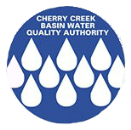Zooplankton
Highlights:
Zooplankton are important in the biological balance of Cherry Creek Reservoir as they serve as the primary food source for small fish and many feed on algae. Zooplankton population dynamics and activity are also affected by water quality and the water clarity can impact ability to feed. The WY2023 populations were lowest following the major storm in early May but the rest of the distributions were similar to previous years.
Zooplankton are microscopic animals that consume algae and bacteria in the water column. Some types of zooplankton feed on algae, others on other zooplankton, and some take in both plant and animal particles. Larger zooplankton can exert significant grazing pressure on algal cells; however, they are also subject to predation as they are a food source for larger crustaceans, aquatic insects and fish.
Most freshwater zooplankton are part of only three phyla: amphipods, which include both cladocerans (shown in green) and copepods (shown in orange); rotifers (shown in yellow); and protozoa (shown in blue). Cladocerans and copepods are microscopic crustaceans that feed primarily on phytoplankton. These organisms can be an important food source for fish and can also exert grazing pressure on phytoplankton populations when present in high enough numbers. Rotifers are microscopic animals that feed on detritus and smaller organisms, such as bacteria. They can also serve as a food source for larger zooplankton. Protozoans are single-celled organisms that feed on other microorganisms, organic matter, and debris.
The invasive water flea, daphnia lumholtzi, a type of cladoceran, is less palatable to fish due to its spines and has been detected in samples 2011. These species are less desirable than other large body daphnia which are an important food source for fish.
Similar to phytoplankton, the zooplankton counts and biomass were lower following the major storm and subsequent rain events during WY2023. The zooplankton population dynamics support that the high inflows, lower water temperatures, reduced residence time and changes in water quality may play a significant role in how the biological food web responds to high magnitude storms over an extended period of time like the spring and early summer of WY 2023.
Useful Links

Zooplankton Concentrations and Biovolumes
info_outlineEach point on this graph represents a sampling event. The y-axis represents the concentration (number) and the size of the bubble represents the biovolume (size). The colors represent different zooplankton groups. Use the filters to target a specific group or date. To learn more about a specific data point, hover over it with your mouse.
